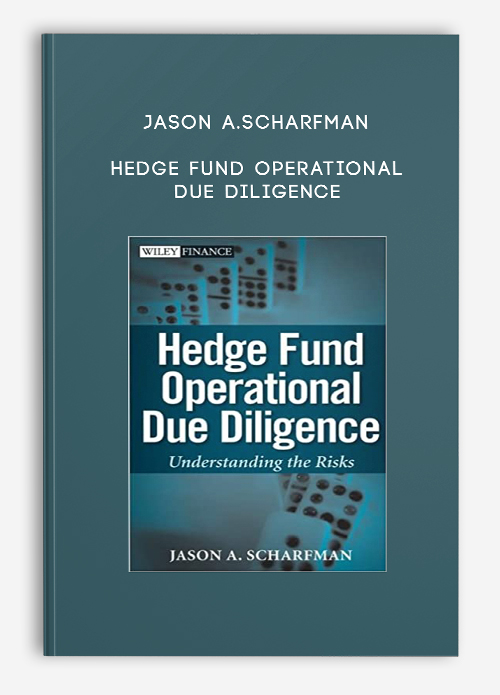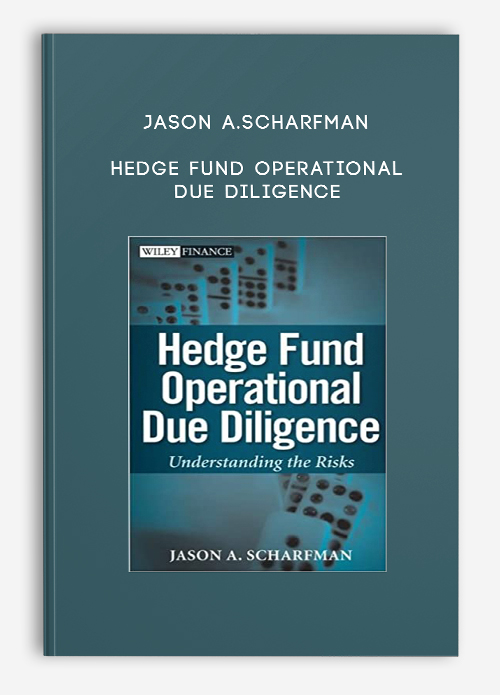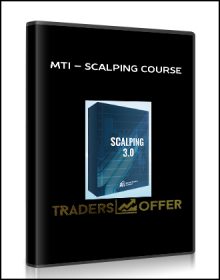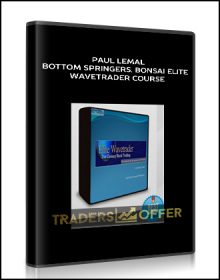Jason A.Scharfman – Hedge Fund Operational Due Diligence
$110.00 $19.00
Product Include:
File size:
Jason A.Scharfman – Hedge Fund Operational Due Diligence
**More information:
Get Jason A.Scharfman – Hedge Fund Operational Due Diligence at Salaedu.com
Description
How to diagnose and monitor key hedge fund operational risks
With the various scandals taking place with hedge funds, now more than ever, both financial and operational risks must be examined. Revealing how to effectively detect and evaluate often-overlooked operational risk factors in hedge funds, such as multi-jurisdictional regulatory coordination, organizational nesting, and vaporware, Hedge Fund Operational Due Diligence includes real-world examples drawn from the author’s experiences dealing with the operational risks of a global platform of over 80 hedge funds, funds
of hedge funds, private equity, and real estate managers.
Table of Contents
Preface.
Chapter 1. What is Operational Risk?
Brief History.
Modern Definition of Operational Risk in a Hedge Fund Context.
Operational Due Diligence versus Operational Risk.
Key Areas.
External Risks.
Internal Risks.
Fund Terms.
Transparency and Reporting.
Blended Risks.
The Five Themes.
Chapter 2. The Importance of Operational Due Diligence.
Why Should Investors Care About Operational Risk?
Morton’s Fork Or A Hobson’s Choice?
Outright Fraud Still Exists.
Hedge Fund Fraud Cannot Be Modeled.
Small Discrepancies Add Up.
Lack Of Standardized Regulation.
Each Hedge Fund Is Different.
Ability To Generate An Informational Edge.
Potential To Reduce Losses And Increase Returns.
Considering Operational Risk Factors Presents A Different View Into A Firm.
Common Misconceptions.
Other Considerations: There Is Not Necessarily A Positive Correlation Between Assets And Operational Quality.
A Study In Operational Failure: Bayou Hedge Fund Group.
Affiliated Broker Dealer.
Large Discrepancies Between The Performance Of Onshore And Offshore Funds.
Declining Capital Of Broker Dealer.
Board Of Directors: Members And Actions.
Lavish Expenses Of Broker-Dealers.
Fake Audits Prepared By A Phony Auditor.
Background Questions.
Lack Of Investor Communication.
Ties To People Barred From The Securities Industry.
Revision Of Conflicted Marketing Materials.
Other Anomalies.
Chapter 3. Who Is Qualified To Perform An Operational Due Diligence Review?
Essential Skills.
Primary Skills.
Primary, Secondary, Blended, And Other Skills.
In-House Versus Outsourcing.
Evolution Of Independent Operational Rating Agencies.
Benefits Of Third-Party Rating Agencies.
Criticisms Of Third-Party Rating Agencies.
Factors To Consider Before Performing An Operational Review Of A Hedge Fund.
Chapter 4. Creating An Initial Operational Profile.
When Does An Operational Due Diligence Review Begin.
Documentation.
The Piñata Problem.
Due Diligence Questionnaire: To Use Or Not To Use?
Background Investigations.
Other Considerations.
Importance Of On-Site Visits.
Which Office To Visit?
Manager Interview Process.
What Topics Should I Cover During An On-Site Review?
Sample Topic Questions.
In What Order Should These Topics Be Covered?
Service Provider Reviews.
Qualitative Operational Report: Documenting The Operational Data.
Chapter 5. Evaluating the Gray Areas: Examples.
Scenario 1: It Was Not Me–Hedge Fund Manager Claims It Is Mistaken Identity.
Scenario 2: It Was Me But, Everyone Was Doing It–Are Regulatory Witch Hunts Real?
Scenario 3: It Was Me But, I Did Nothing Wrong–Manager Proved Not Guilty.
Scenario 4: The Low Profile Hedge Fund Manager–Is No News Good News?
Scenario 5: The Infrastructure Outsourcer–Can An Administrator Do Everything?
Scenario 6: The Mountain Climber – Can Plans For Large Fast Growth Trip You Along The Way?
Scenario 7: The Stumbling Giant–Can A Large Manager Lose Sight Of Small Controls?
Scenario 8: The Apologetic Headmaster–Are Junior Staff As Informed As Senior Management?
Chapter 6. Ten Tips When Performing an Operational Due Diligence Review.
Tip 1. Meeting With The Wrong People Or The Wrong Groups.
Tip 2. Get Out Of The Conference Room.
Tip 3. Little White Lies Can Turn Into Big Problems.
Tip 4. Be Wary Of Phantomware.
Tip 5. Focus On Documentation And Negotiation.
Tip 6. Read The Fine Print (Financial Statement Notes Etc.).
Tip 7. Reference Checking: The Importance Of In-Sample And Out Of Sample References.
Tip 8. Credit Analysis: Are Funds Financially Viable?
Tip 9. Long-Term Planning: Key Staff Retention, Succession Planning, And More.
Tip 10. Growth Planning: Is The Manager Pro-Active Or Reactive??
Chapter 7. On-going Operational Profile Monitoring.
How Often Should Background Investigations Be Renewed?
Remote Operational Due Diligence Monitoring.
Media Monitoring.
Litigation And Regulatory Monitoring.
Hedge Fund Communication Reviews.
Assets Under Management And Performance Monitoring.
Operational Events.
Effect Of Discovery On The Magnitude Of An Operational Event.
On-Site Visit Frequent And Operational Events.
Developmental Operational Traps.
Multi-Jurisdictional And Intra-Jurisdictional Regulatory Coordination.
Silo Creation.
Organizational Nesting.
Chapter 8. Techniques For Modeling Operational Risk.
Scoring Systems.
Building a Scoring System: Category Determination.
Category Definitions.
Category Definitions: Combinations of Approaches.
Category Weight Assignment.
Weighting Aggregation Model.
Weighting Disaggregation Model.
WAM versus WDM.
Category Weight Consistency and Re-weighting Considerations.
Factor marginalization.
Category Scale Determination and The Meaning of Scores.
Threshold Self-Assessment and Determination.
Score Assignment.
Discretionary Penalties and Bonuses.
Discretionary Magnitudes.
Score Aggregation: Sum Totaling and Weighted Averages.
Criticisms of scorecard models.
Benefits of scorecard models.
Visualization Techniques.
TreeMapping.
Chapter 9. Bridging the Gap: Incorporating Operational Risk Consideration Into the Portfolio Construction and Asset Allocation Process.
Pro-Active Monitoring: Graphical Universe Creation.
Pro-Active Management Of Operational Risks.
Protecting Against Conglomeration Risks: Multivariate Commonality Analysis.
Operational Directional Views.
Example Of Multivariate Commonality Analysis.
First Objective: Total Diversity Goal.
Second Objective: FSA Overweight Goal.
Third Objective: FSA Underweight Goal.
Conclusions Of Scenario Analysis.
Considering Operational Reviews In The Hedge Fund Portfolio Rebalancing Process.
Operational Drag.
Meta Risks.
Operational Factor.
Operational Scenario Analysis.
Can Operational Risk Be Entirely Eliminated?
Factoring Operational Risk Into Total Risk Calculations.
Beyond Scorecard Approaches: Discounting Expected Return.
Discounted Expected Returns With The Operational Factor.
Operational Haircuts.
Expected Return And Operational Risk.
Shape Of The Expected Return Versus Operational Risk Curve.
Second Operational Threshold.
Final Thoughts.
Chapter 10. Looking Ahead: Trends in the Space.
Increased Use Of Consultants.
Commoditization Of Background Investigations And Canned Operational Due Diligence Reports.
Increased Reliance On Service Provider Consulting Services.
Capturing Of Hedge Funds By Service Providers And Employees.
Hedge Fund Pursuit Of Audit Certifications.
Operational Activism.
AU 332 And FAS 157.
Development Of Hedges To Operational Risks.
Links Between Operational Risk And Credit Analysis.
Proposed Re-Regulation Of The Hedge Fund Industry.
Index.
Author Information
JASON A. SCHARFMAN is a Director with Graystone Research at Morgan Stanley. His responsibilities include analyzing and reporting on the operational risks of alternative investments such as hedge funds, funds of hedge funds, and private equity considered for investment. He also makes recommendations to the firm’s investment committee based on that analysis. He has written on the subject of operational due diligence and travels and speaks worldwide on hedge fund operational risks.
Reviews
“Informative book by Jason Scharfman, on, well, pretty much everything you need to run a hedge fund…Scharfman also explains the reliance on technology that is becoming ever more apparent in hedge funds, the dangers of phantomware, and questions that should be asked before committing to any new technology.” (hedgeco.net, January 26th, 2009)
“In his book, Jason Scharfman identifies these operational risks and recommends a strong and innovative “operational” due diligence review program as the best defense against them. His book outlines a step-by-step guide that shows investors how to effectively detect and evaluate often-overlooked operational risk factors in hedge funds and other investments in order to provide hedge funds and their investors with the skills to understand and hopefully mitigate these risks.” (The Hedge Fund Law Report, January 8, 2009)
Forex Trading – Foreign Exchange Course
Want to learn about Forex?
Foreign exchange, or forex, is the conversion of one country’s currency into another.
In a free economy, a country’s currency is valued according to the laws of supply and demand.
In other words, a currency’s value can be pegged to another country’s currency, such as the U.S. dollar, or even to a basket of currencies.
A country’s currency value may also be set by the country’s government.
However, most countries float their currencies freely against those of other countries, which keeps them in constant fluctuation.
1 review for Jason A.Scharfman – Hedge Fund Operational Due Diligence
Add a review Cancel reply
Related products
Forex - Trading & Investment
Forex - Trading & Investment
Pristine – Paul Lange – Creating & Using a Trading Plan + Seven Steps to a Good Trade
Forex - Trading & Investment
Forex - Trading & Investment
Paul Lemal – Bottom Springers. Bonsai Elite WaveTrader Course (8 DVDs & Manuals)











king –
We encourage you to check Content Proof carefully before paying.“Excepted” these contents: “Online coaching, Software, Facebook group, Skype and Email support from Author.”If you have enough money and feel good. We encourage you to buy this product from the original Author to get full other “Excepted” contents from them.Thank you!